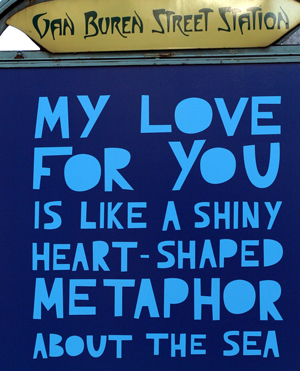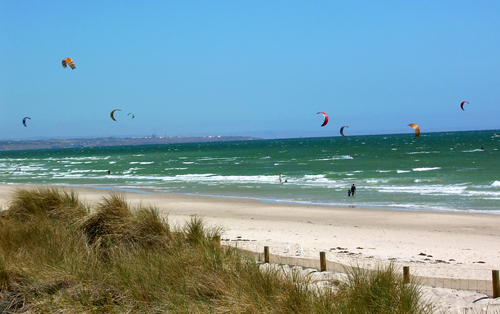
Source: “There’s a metaphor here”, opacity, Flickr
Are you scratching your head after reading the simile in the picture? Love is like a what? Do you think this might be an example of someone who isn’t quite sure about the definition of a simile or a metaphor and what they can do for our writing?
You have probably spent years examining examples of figurative language in poems, stories, and plays. You know how important it is for a writer to use comparisons so that you, the reader, can see exactly what the writer is describing. In the example on the left, we aren’t sure what the writer is comparing love to—a heart shaped metaphor about the sea? Most of the time, however, a writer’s use of figurative language clears up the picture in our heads as we read. Maybe you’ve used similes and metaphors in your own writing or speaking—as valentines to special people or in discussions with parents. For example, maybe you have said something like “Oh, my math test? It will be a breeze.”
You might think that only poetry and fiction contain imagery, but nonfiction writing contains imagery, too. Writers create mental images to persuade a reader to see their point of view or to help the reader experience a place or event. Sensory language helps us visualize the scenes and events it describes. The images that writers create help us to understand what we are reading. By appealing to our senses, writers engage us and show us that reading is worth the time and effort.
Let’s say you are reading a memoir about a trip to the beach. Which of the descriptions below would make you want to read more?

Source: “Windy day on the beach,” kerryj.com, Flickr
Description A
I went to the beach last weekend and it was windy. I had to hold onto my favorite hat. The ocean was cold and blue. I had a very good time.
Description B
We hit the beach early on Saturday, the last day of our trip. As soon as I got out of the car, I smelled the salty air and heard waves roaring in my ears. The crystal blue water gleamed like a sapphire. The wind yanked my hat like a strongman playing tug-of-war, but I managed to hold onto it.
Description A is not vivid or interesting, but description B makes you feel as though you were there, doesn’t it?
Writers use sensory imagery (“smelled the salty air”), similes (“like a strong man playing tug-of-war”), and metaphors (“the waves roaring in my ears”) to capture the reader’s imagination. In this lesson, you will learn how to identify and evaluate the use of imagery, simile, and metaphor in nonfiction writing.